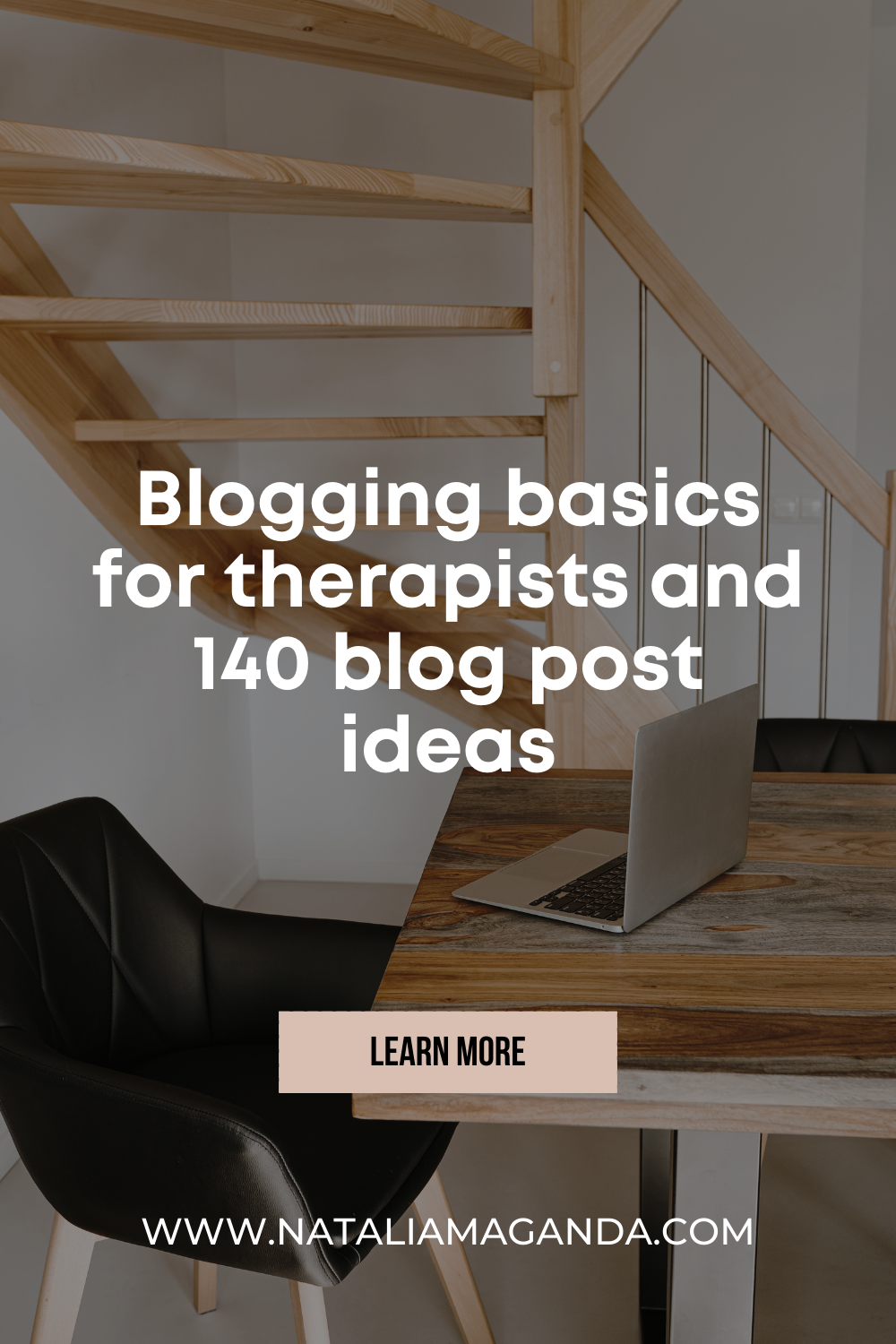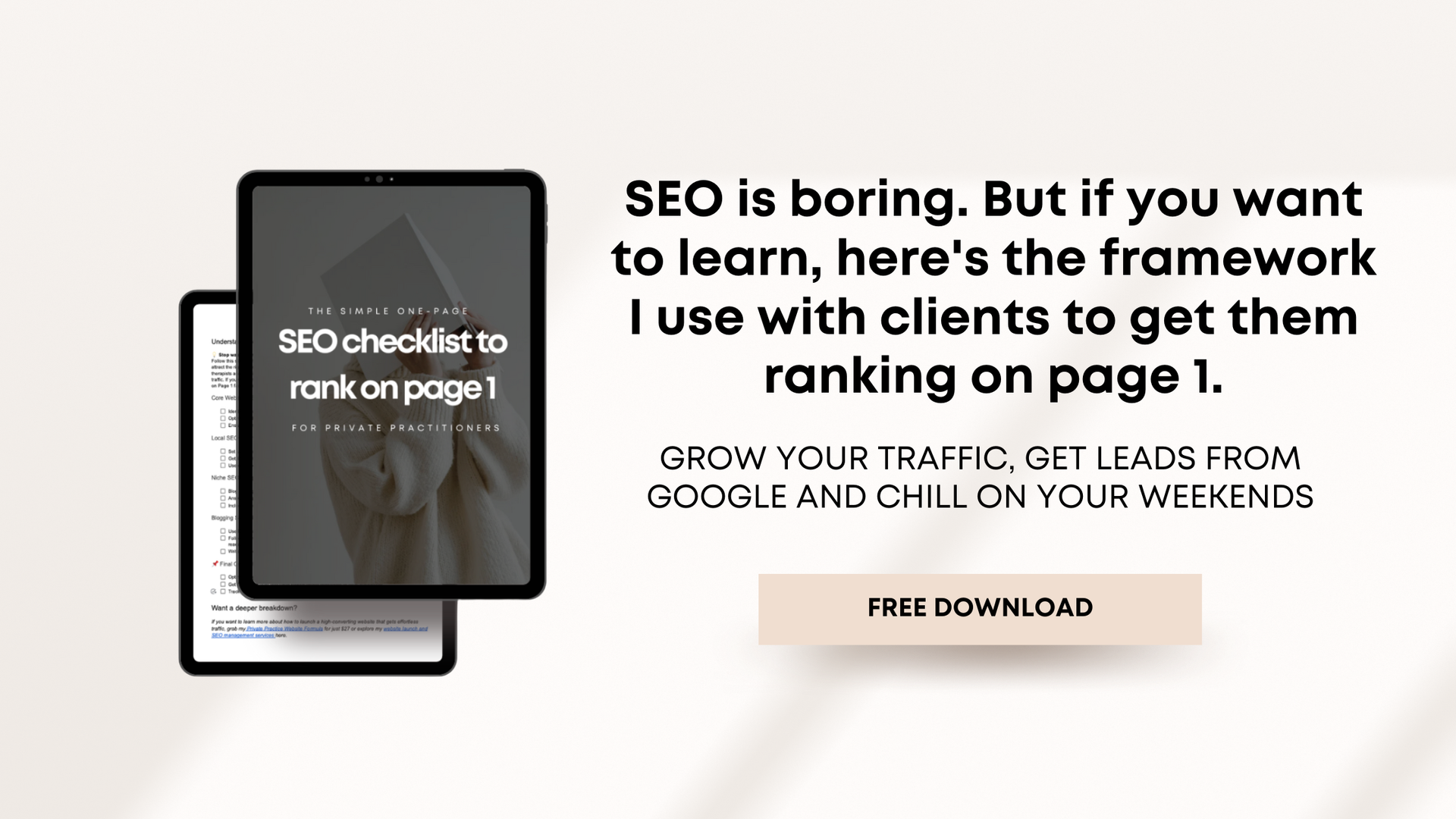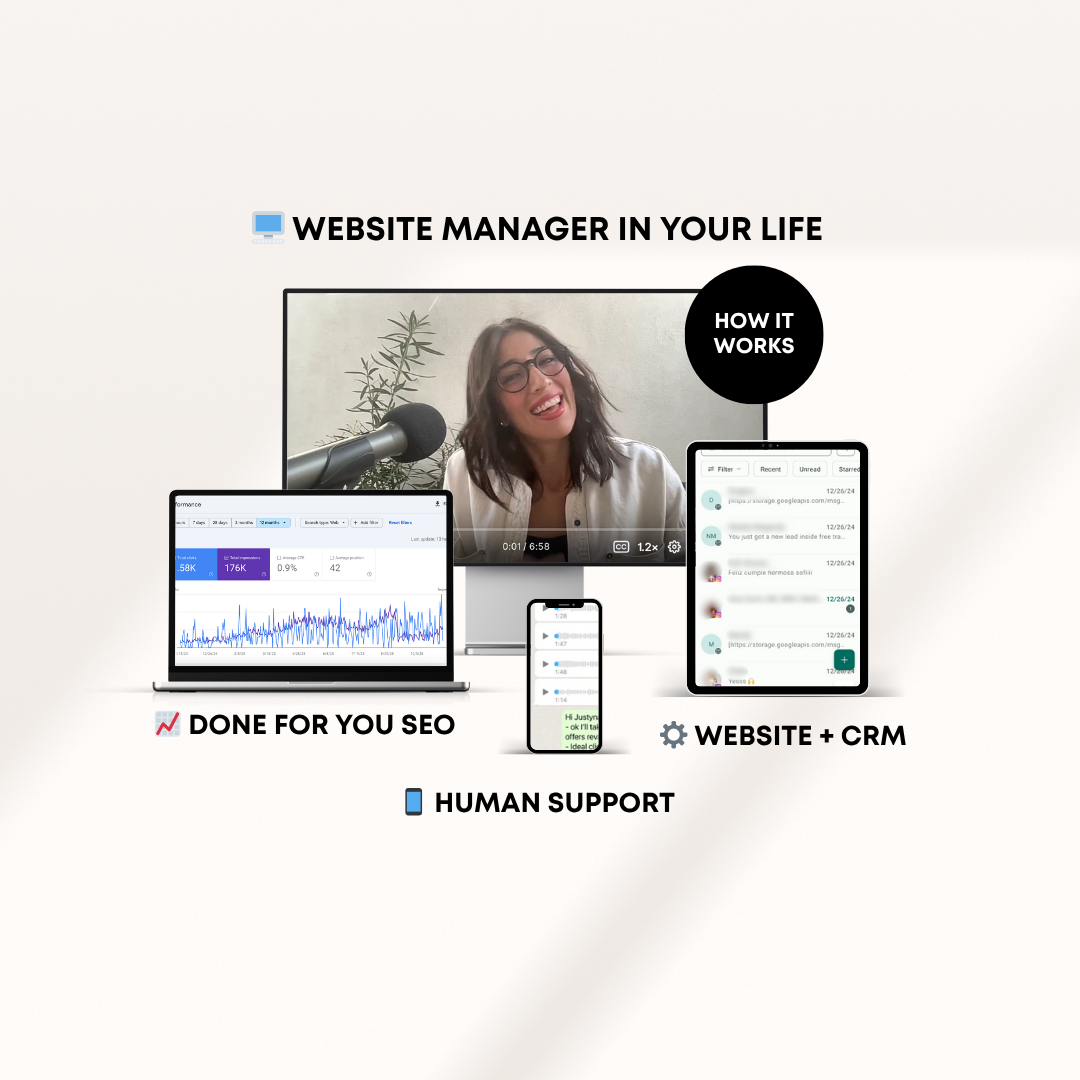Blogging basics for therapists and 140 blog post ideas
Hey there, amazing therapists and life coaches! If you’re juggling a tight schedule and wondering if blogging is worth your time, you’re in the right place. Blogging can help you rank on Google, attract more aligned leads, and grow your practice. And guess what? You can achieve this with just one hour per week!
In case we haven’t met yet, I’m Natalia Maganda, a website designer for therapists . I help ambitious life coaches and mental health professionals amplify their magic, gain visibility, and simplify their marketing efforts through strategic web design and content.
In-person therapists and mental health professionals from online therapy platforms such as BetterHelp are helping people cope with their mental health concerns.
Blogging might seem like a daunting task, especially with your already busy schedule. But with a bit of planning and some strategic effort, it can be a game-changer for your practice. Not only does it help you share your expertise and connect with your audience, but it also boosts your online presence and helps you rank higher on search engines. Let’s dive into the basics of blogging and how you can make it work for you, even if you only have an hour a week to spare.
* This post contains sponsored links
Do therapists need a blog?
Absolutely! Blogging allows you to share your knowledge and establish yourself as an authority in your field. By providing valuable content, you build trust with potential clients before they even step into your office.
Regularly updated blogs improve your website’s search engine ranking, making it easier for people to find you. Blogs give you a platform to connect with your audience, answer their questions, and address their concerns.
What type of blog do I need for my private practice?
To get started, you’ll need:
- A clear focus: Decide on your niche and the topics you’ll cover.
- Consistent posting schedule: Aim for at least one blog post per month to keep your content fresh.
- Quality content: Focus on creating valuable, informative, and engaging content that resonates with your audience.
What do I need to consider for starting a blog that gets traffic and leads for my private practice?
Optimize your website for SEO
Search engine optimization (SEO) is crucial for getting your blog noticed. Here are some tips:
- Use relevant keywords: Identify keywords related to your niche and incorporate them naturally into your content.
- Write compelling titles and meta descriptions: These are the first things people see on search engine results pages.
- Make sure your blogs are in line with your niche: This means to avoid broader topics, I know you may feel the urge to write about generic mental health topics, but the more you stick to your specific niche, the better SEO results you’ll get.
Plan strategic keywords related to your area of specialization
Use tools like Google Keyword Planner or Ubersuggest (my favorite) to find keywords that your potential clients are searching for. Incorporate these keywords into your blog posts, headings, and meta descriptions.
Have a lead magnet because not everyone will be ready to inquire from cold traffic
A lead magnet is an incentive you offer to potential clients in exchange for their contact information. This could be a free e-book, a checklist, or any source of digital download. Make sure it’s something valuable that addresses a specific problem your audience faces.
Here’s an example of a lead magnet for a therapist specializing in anxiety:
“Download my free guide: ‘10 Simple Techniques to Manage Anxiety’ and start feeling better today!”
Set up a basic welcome email after someone downloads your free resource
Automate a welcome email to go out immediately after someone downloads your lead magnet. Thank them for signing up, introduce yourself, and provide them with the promised resource.
How to get my blogs showing up on Google
Learn SEO
Understanding the basics of SEO is essential. The key elements of SEO include:
- Keyword Research : Finding and using the right keywords.
- On-Page SEO : Optimizing your content and SEO settings on your website backend.
- Off-Page SEO : Building backlinks from other websites.
- Technical SEO : Ensuring your website is fast, mobile-friendly, and secure.
How to manage having a blog as a busy therapist?
Get organized and start content batching
Content batching involves creating multiple pieces of content in one sitting. This approach helps you stay ahead and ensures you always have content ready to post.
Plan the next 4, 8, 12, 24, or 48 blog post ideas
Start by brainstorming topics and creating a content calendar. This helps you stay organized and ensures you cover a variety of topics.
Plan your blog post outlines in advance
Outline your blog posts before you start writing. This makes the writing process faster and more efficient.
Then open up your blog post outlines and write them in a dedicated day each month
Set aside one day each month to write your blog posts. Having outlines ready will make this process much smoother.
Here’s the list of 140 blog post ideas for therapists organized by specialization
Child and Teen Therapy
- Tips for Parents to Help Anxious Children
- How to Support Your Child Through a Divorce
- Understanding and Managing ADHD in Children
- The Benefits of Play Therapy for Kids
Couples and Marriage Counseling
- How to Improve Communication in Your Relationship
- Common Marriage Problems and How to Fix Them
- The Importance of Trust in a Relationship
- Tips for Keeping the Romance Alive
Family Therapy
- How to Handle Family Conflicts
- The Role of Family Therapy in Healing Trauma
- Strategies for Blended Families
- The Impact of Parental Mental Health on Children
Trauma and PTSD Counseling
- Understanding PTSD: Symptoms and Treatments
- How Trauma Affects the Brain
- The Importance of Therapy in Healing Trauma
- Coping Strategies for Trauma Survivors
Anxiety and Depression Therapy
- How to Recognize the Signs of Anxiety
- Coping Techniques for Depression
- The Benefits of Cognitive Behavioral Therapy for Anxiety
- How Mindfulness Can Help with Anxiety and Depression
Substance Abuse and Addiction Counseling
- Signs of Substance Abuse in Teens
- The Role of Family in Addiction Recovery
- Coping with Relapse: What You Need to Know
- How to Support a Loved One with an Addiction
Eating Disorders Therapy
- Understanding Different Types of Eating Disorders
- The Role of Nutrition in Eating Disorder Recovery
- How to Support a Friend with an Eating Disorder
- The Importance of Therapy in Eating Disorder Recovery
Grief and Loss Counseling
- Coping with the Loss of a Loved One
- How Grief Affects Your Mental Health
- The Stages of Grief Explained
- Tips for Supporting Someone Who Is Grieving
Cognitive Behavioral Therapy (CBT)
- What Is CBT and How Does It Work?
- The Benefits of CBT for Anxiety and Depression
- CBT Techniques You Can Try at Home
- How CBT Helps with Negative Thought Patterns
Dialectical Behavior Therapy (DBT)
- An Introduction to DBT
- The Benefits of DBT for Borderline Personality Disorder
- DBT Skills for Managing Emotions
- How to Find a DBT Therapist
Mindfulness-Based Therapy
- What Is Mindfulness-Based Therapy?
- The Benefits of Mindfulness for Mental Health
- How to Practice Mindfulness Daily
- Mindfulness Exercises to Try at Home
Art Therapy
- The Healing Power of Art Therapy
- How Art Therapy Helps with Trauma
- Art Therapy Techniques for Anxiety
- The Benefits of Art Therapy for Children
Play Therapy
- What Is Play Therapy and How Does It Work?
- The Benefits of Play Therapy for Children
- Play Therapy Techniques You Can Try at Home
- How to Find a Play Therapist
Sex Therapy
- What Is Sex Therapy and How Can It Help?
- The Benefits of Sex Therapy for Couples
- Common Issues Addressed in Sex Therapy
- How to Talk to Your Partner About Sex Therapy
LGBTQ+ Affirmative Therapy
- The Importance of LGBTQ+ Affirmative Therapy
- How to Find an LGBTQ+ Affirmative Therapist
- Common Issues Addressed in LGBTQ+ Therapy
- The Benefits of Therapy for LGBTQ+ Youth
Career Counseling and Coaching
- How to Find a Career You Love
- The Benefits of Career Counseling
- Tips for a Successful Career Change
- How to Overcome Career Burnout
Sports Psychology
- The Role of Sports Psychology in Athletic Performance
- How to Handle Performance Anxiety
- The Benefits of Mental Training for Athletes
- How to Find a Sports Psychologist
Holistic and Integrative Therapy
- What Is Holistic Therapy?
- The Benefits of Integrative Therapy
- How to Incorporate Holistic Practices into Your Life
- The Role of Nutrition in Mental Health
Psychodynamic Therapy
- An Introduction to Psychodynamic Therapy
- The Benefits of Psychodynamic Therapy for Depression
- How Psychodynamic Therapy Helps with Self-Understanding
- What to Expect in a Psychodynamic Therapy Session
Psychoanalytic Therapy
- What Is Psychoanalytic Therapy?
- The Benefits of Psychoanalytic Therapy for Trauma
- How to Find a Psychoanalytic Therapist
- Understanding Transference in Psychoanalytic Therapy
Forensic Psychology
- The Role of Forensic Psychology in the Legal System
- How Forensic Psychologists Assess Criminal Behavior
- The Importance of Mental Health Evaluations in Court Cases
- Career Paths in Forensic Psychology
Neuropsychology
- What Is Neuropsychology?
- The Benefits of Neuropsychological Assessments
- How Neuropsychology Can Help with Learning Disabilities
- Understanding Brain-Behavior Relationships
Health Psychology
- The Role of Health Psychology in Chronic Illness Management
- How Health Psychologists Help with Behavior Change
- The Impact of Stress on Physical Health
- Strategies for Improving Health Through Psychological Interventions
Clinical Supervision and Training
- The Importance of Clinical Supervision for Therapists
- How to Find a Good Clinical Supervisor
- Tips for New Therapists Starting Supervision
- The Benefits of Ongoing Training for Mental Health Professionals
Teletherapy and Online Counseling
- The Benefits of Teletherapy for Clients and Therapists
- How to Set Up a Successful Teletherapy Practice
- Common Challenges in Online Counseling and How to Overcome Them
- The Future of Teletherapy: Trends to Watch
Hypnotherapy
- What Is Hypnotherapy and How Does It Work?
- The Benefits of Hypnotherapy for Anxiety and Phobias
- How to Find a Qualified Hypnotherapist
- Common Misconceptions About Hypnotherapy
Geriatric Counseling
- The Importance of Mental Health Care for Older Adults
- Common Issues Addressed in Geriatric Counseling
- How to Support the Mental Health of Elderly Loved Ones
- The Benefits of Therapy for Older Adults
Veterans and Military Counseling
- The Unique Mental Health Needs of Veterans
- How to Support a Veteran's Transition to Civilian Life
- The Role of Counseling in Treating PTSD in Veterans
- Resources for Veterans Seeking Mental Health Support
School Counseling
- The Role of School Counselors in Student Mental Health
- How School Counselors Support Academic and Emotional Development
- Common Challenges Faced by School Counselors
- Tips for Parents to Support Their Child's School Counselor
Occupational Therapy
- What Is Occupational Therapy?
- The Benefits of Occupational Therapy for Mental Health
- How Occupational Therapy Helps with Everyday Functioning
- The Role of Occupational Therapy in Rehabilitation
Behavioral Therapy for Autism
- The Benefits of Behavioral Therapy for Children with Autism
- How to Find a Behavioral Therapist for Autism
- Common Techniques Used in Behavioral Therapy for Autism
- Success Stories in Behavioral Therapy for Autism
Life Coaching
- The Differences Between Therapy and Life Coaching
- How Life Coaching Can Help You Achieve Your Goals
- Finding the Right Life Coach for You
- The Benefits of Life Coaching for Mental Health Professionals
Chronic Illness Counseling
- The Psychological Impact of Living with a Chronic Illness
- How Counseling Can Help with Chronic Illness Management
- Strategies for Coping with Chronic Pain
- The Role of Mental Health in Chronic Illness Treatment
Pain Management Counseling
- The Benefits of Pain Management Counseling
- Techniques for Managing Chronic Pain
- How to Find a Pain Management Counselor
- The Role of Mindfulness in Pain Management
Stress Management Counseling
- The Importance of Stress Management for Mental Health
- Techniques for Reducing Stress in Daily Life
- How Stress Management Counseling Can Help
- The Role of Exercise and Nutrition in Stress Management
Blogging can be a powerful tool to connect with clients, showcase your expertise, and grow your practice.
By dedicating just one hour a week, you can create valuable content that attracts and engages your audience. Remember, the key is consistency and providing genuine value.
Explore my
web design services for therapists
. Let’s work together to amplify your magic and simplify your marketing efforts. Happy blogging!
Related reads:
- The ultimate guide to branding your therapy and private practice
- 10 simple ways to get more therapy clients for your private practice
20 modern therapist logo ideas - How to write an engaging Psychology Today profile
- SimplePractice vs TherapyNotes in-depth comparison
- Therapist networking tips and where to find online events

* AI Disclosure: This content may contain sections generated with AI with the purpose of providing you with condensed helpful and relevant content, however all personal opinions are 100% human made as well as the blog post structure, outline and key takeaways.
* Affiliate Disclosure: Some of the links on www.nataliamaganda.com may contain affiliate links meaning that I will get a commission for recommending products at no extra cost to you.

hello! i'm natalia
Latina, web design expert for mental health professionals.
I help ambitious life coaches, therapists and holistic leaders amplify their magic, gain visibility, and simplify their marketing efforts through strategic web design and content.
If you’re looking for an all-in-one system to manage your website, emails, funnels, and CRM, Go HighLevel (affiliate link) is the most powerful tool I’ve tested—and it’s built to grow with you.
On a tighter budget or just starting out? ThriveCart (affiliate link) offers a one-time payment option and easy checkout setups that still pack a punch for digital offers and automation. (Send me an email after your purchase and make sure to use my affiliate link)







